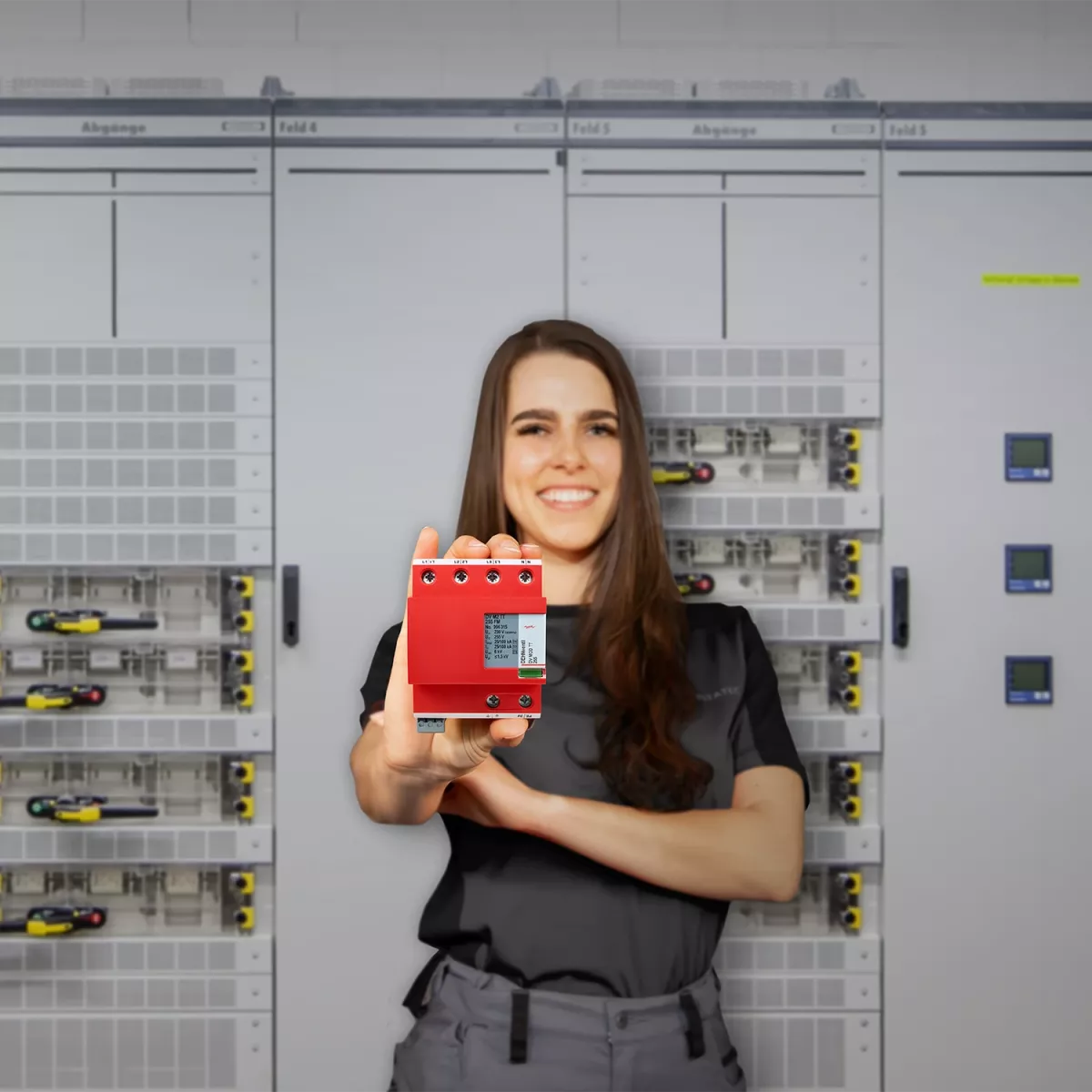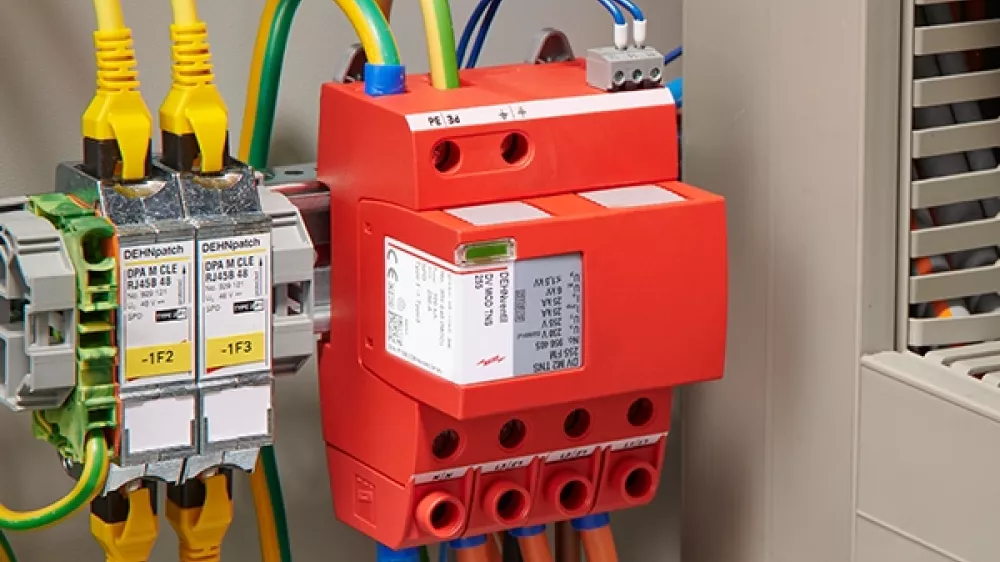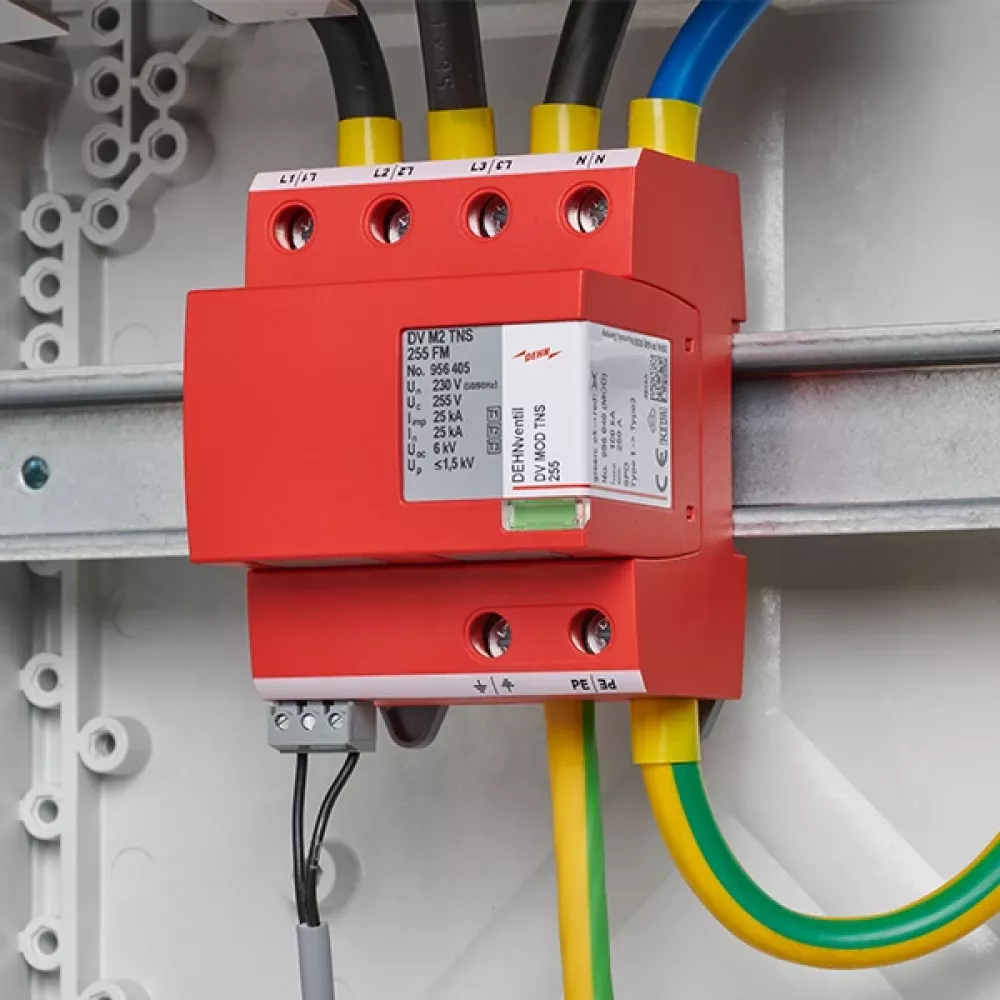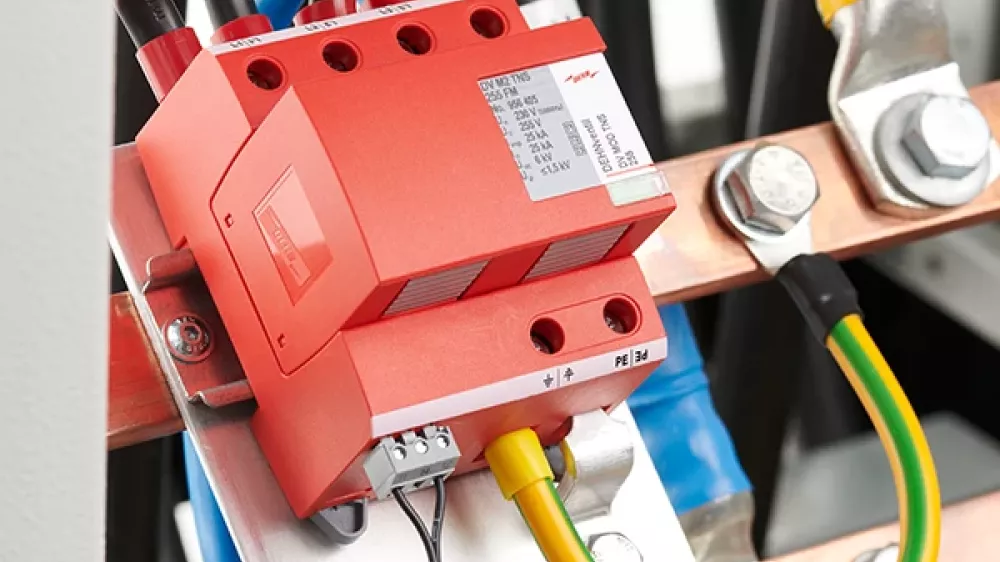Extremely good – down to the last detail: the DEHNventil M2 series
With the DEHNventil M2 series, you're getting maximum performance in the smallest installation space. Flexible to use, the combined arresters protect industrial low-voltage switchgear reliably and without interruption with a compact single module. The tested Type 1 + 2 + 3 combined arresters in accordance with EN 61643-11 provide lightning equipotential bonding, surge protection and terminal device protection in just one device.
- future-proof
- space-saving
- powerful
- reliable

Technical features at a glance
Can be used in all system configurations
The right solution for every requirement: Discover the diversity of the DEHNventil M2 series. The surge arresters are available for use in TNS, TNC, TT and TN systems.
A power density that is unrivalled
Never before has so much power been possible in so little space:
- Suitable for all classes of LPS
The Type 1 + 2 + 3 combined arrester is therefore the first choice, particularly in industrial environments and for increased technical requirements. - Modularity
The plug-in block enables quick and safe replacement. All phases are replaced simultaneously. - Application in industry
Can be used in systems with short-circuit currents of up to 100 kArms. - Lower system load
The fast RAC technology largely isolates the downstream system from harmful lightning currents. - Safe and flexible installation support
Serial wiring with optionally available pin connection terminal for flexibility and safety during installation.
Installation video
The installation video provides you with the required tools, step-by-step installation instructions and an insight into the technical features.

RAC spark gap technology
Speed is safety: Because the RAC (Rapid Arc Control) technology reacts extremely quickly and allows less residual energy to pass through, downstream systems are protected and the service life of the connected devices is thus extended. With RAC technology, electric arcs are fed into the arcing chambers at lightning speed, split into individual sub-arcs and quenched.
Want to find out more about RAC spark gap technology? We will gladly show you further explanations of the function and advantages of this technology.
FAQs
The compact combined arrester shows its strengths above all in industrial low-voltage switchgear installations. It provides lightning equipotential bonding and terminal equipment protection at the same time. In industrial networks with mains follow currents of up to 100 kA, it is used for class of LPS 1 to 4.
For stub wiring with the maximum backup fuse, the previously required backup fuse of 315 A has been reduced to 250 A. This creates more space in the terminal compartment of low-voltage switchgear installations. Another advantage: Shorter cable lengths for connecting the combined arrester make it possible to use the smaller NH1 fuse switch disconnector instead of the previously required NH2 disconnector.

Compared to the predecessor model, DEHNventil M2 has half the width. The usual feed-through wiring with double terminals is therefore no longer possible. If you prefer this type of connection, use STAK 25 (part. no. 952589) to safely conduct operating currents of up to 100 A.

The new DEHNventil M2 offers these advantages:
1) Half width for DEHNventil M: 4 standard DIN modules
2) Convenient mechanism for easy module change
3) Maximum prospective short-circuit current 100kA
4) Single module: One module for the entire connection of the arrester
5) Remote signalling always included
6) "V-connection" with STAK 25 and stub wiring possible
7) Rotated installation possible: 180° rotation
8) Max. backup fuse: 250 A – additional space savings thanks to smaller fuse switch disconnector NH1 (instead of NH2)
9) 5 instead of 10 variants
10) Combined arresters Type 1+2+3 with RAC spark gap technology

No, this is an example of an installation tool. It is usually made by the switchgear manufacturers themselves and serves to simplify installation.

No, connection and safe operation are possible without wire end ferrules thanks to the cage clamps used.
DEHNventil M2 is a Type 1+2+3 combined arrester tested according to DIN EN 61643-11. Therefore, the respective value of the test voltage for the Type 3 test must also be shown. In this context, the UOC specification corresponds to the value of the Type 3 test voltage. This value is defined as the "open-circuit voltage of the hybrid generator at the connection point of the test specimen" and corresponds to 6 kV for DEHNventil M2.
According to DIN EN 61643-11, the follow current extinguishing capability Ifi is the prospective short-circuit current that can be interrupted by the SPD independently and without disconnection. Ideally, this value should be greater than or equal to the short-circuit strength Isccr. This is the highest prospective short-circuit current of the electrical network for which the arrester is rated in conjunction with its specified arrestor disconnector (DIN EN 61643-11). DEHNventil M2 is able to automatically quench a follow current of up to 100 kArms (tested by VDE).
The DEHNventil M2 combined arrester can be used in switchgear with prospective short-circuit currents greater than 50 kArms (VDE tested). A further test has also shown that it can be used up to a maximum prospective short-circuit current of 100 kArms (220 kApeak).
The application and connection of surge arresters is regulated in DIN VDE 0100-534 (2016-10). Here, a connection to the protective conductor of the customer's system and additionally to the main earthing busbar/main earthing terminal is required for type 1 surge arresters. Both connections are shown in the picture. The protective conductor connection is made via the earthed mounting plate (right terminal on DEHNventil M2), the connection to the main earthing busbar (left-hand connection to the PE busbar).
Note: In industrial switchgear installations with cross-sections over 150 mm2, a separate connection of the surge arrester to the main earthing busbar can be dispensed with, as these are already connected with a connecting cable and a corresponding cross-section. This is also described in question 6 on page 21 of the German brochure on "Protection against surges in low-voltage systems" published by the Central Association of the German Electrical and Information Technology Trades (ZVEH).

The mounting plate shown in the figure is not made of aluminium. This is tin-plated copper material (Cu/gal Sn). Galvanically tin-plated components, such as copper cable lugs, are used for corrosion protection. Thus, the PE busbar (Cu) and the mounting plate (Cu/gal Sn) shown in the picture do not constitute a material combination that is susceptible to corrosion.

DIN EN 60999-1 applies to all screw and screwless clamp connections. The standard specifies that connections must be designed by the manufacturer so that all unprepared conductor types can be connected.
The clamps used in the remote signalling contacts and for connecting the DEHNventil M2 are so-called "cage clamps". As full contact is ensured here even with stranded wires, we recommend connection without wire end ferrules. The connection example can also be found in our installation instructions. You can find the installation instructions in the Technical Data of our DEHNventil M2 products.
DEHNventil is also available for the 40 mm busbar system: The combined lightning current and surge arresters DEHNventil ZP TNC (Part No. 900 390) and DEHNventil ZP TT (Part No. 900 391) are specially designed for the 40mm busbar connection panel of the meter mounting board. The DEHNventil ZP can be used in buildings with external lightning protection with class of LPS I and II. For (residential) buildings with external lightning protection with class of LPS III/IV or for residential buildings without external lightning protection, our proven DEHNshield ZP product range, for example the DSH ZP 2 SG TT 255, can be used.
Downloads
The DEHNventil M2 series – extremely good!
The DEHNventil M2 series – extremely good!
Product selection: Lightning and surge protection
Our services
We support your project right from the start: from the risk assessment to planning the earthing system and external lightning protection.
With DEHNrisk, you can determine the lightning risk for structures comprehensively, quickly and precisely. The Web-based application provides support in determining the lightning protection class and other necessary measures.
We create the entire lightning protection concept – from the risk analysis and earthing simulation to budget planning – all precisely tailored to your project and standard-compliant.











